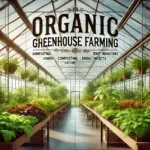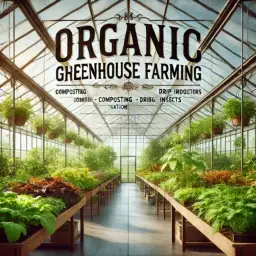Organic greenhouse farming is growing plants in a controlled environment without using chemicals. This method is important because it helps the environment by reducing harmful substances and promoting biodiversity. Organic farming and greenhouse cultivation are essential for sustainable agriculture and natural farming.
What is Organic Greenhouse Farming?
Organic greenhouse farming involves growing plants in a greenhouse using organic methods. This means no chemical fertilisers or pesticides are used, and farmers use natural farming techniques to keep the plants healthy.
Benefits of Organic Greenhouse Farming for the Environment
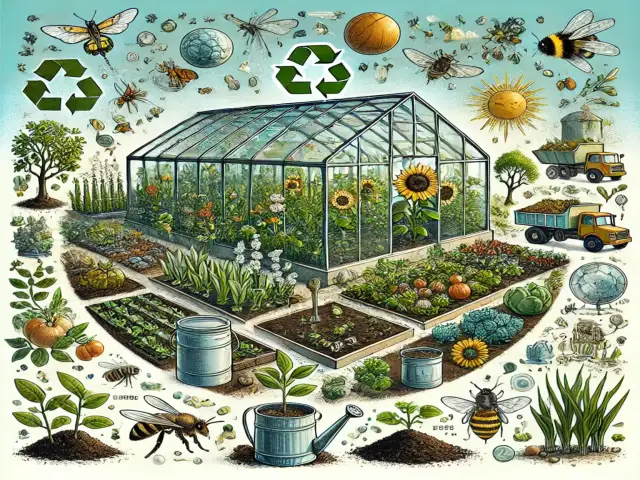
Organic greenhouse farming is a special way to grow plants. It means growing plants inside a greenhouse without using chemicals.
Why Organic Greenhouse Farming is Good for the Environment
No Harmful Chemicals
Organic greenhouse farming doesn’t use chemical fertilisers or pesticides, so no harmful substances enter the soil or water.
Healthy Soil
Organic farming helps keep the soil healthy. Farmers use compost and natural fertilisers to give the soil nutrients.
Less Pollution
Organic farming reduces pollution by not using chemicals.
More Biodiversity
Organic farming encourages more kinds of plants and animals to live in and around the greenhouse.
Lower Carbon Footprint
Organic greenhouse farming often uses less energy than traditional farming.
Supports Wildlife
Without harmful chemicals, birds, bees, and other wildlife can thrive. These creatures are important for pollinating plants and keeping pests under control. Organic farming creates a safe home for them.
Best Crops for Organic Greenhouse Farming
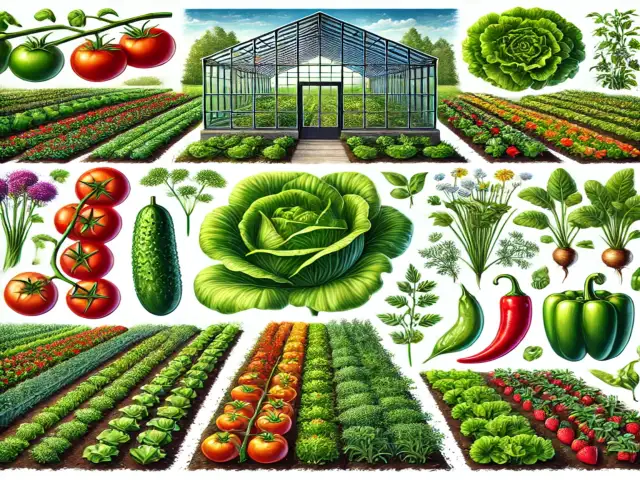
Let’s look at some of the best crops to grow organically in a greenhouse.
Tomatoes
Tomatoes grow very well in greenhouses. They need a warm, stable environment. With organic methods, you can grow tasty and healthy tomatoes.
Cucumbers
Cucumbers also love greenhouses. They need a lot of water and a warm place to grow. Growing them organically means they will be free from harmful chemicals.
Lettuce
It grows quickly and only needs a little space. Organic lettuce is fresh and crunchy.
Herbs
Herbs like basil, parsley, and mint do well in greenhouses. They need good sunlight and organic soil. Fresh herbs add great flavour to your meals.
Peppers
Peppers, including bell peppers and hot peppers, grow well in greenhouses. They need warmth and good care. Organic peppers are colourful and nutritious.
Strawberries
Strawberries are a sweet treat that can be grown in a greenhouse. They need a lot of light and water.
These crops are some of the best for organic greenhouse farming. They grow well in controlled environments and are free from harmful chemicals. Growing these plants organically ensures they are healthy and tasty.
Challenges of Organic Greenhouse Farming
Challenges of Organic Greenhouse Farming
Pest Control
Controlling pests without chemicals can be difficult.
Disease Management
Plants can get sick, and managing diseases without chemicals is a challenge.
Higher Labor Costs
Organic farming often requires more hands-on work.
Access to Organic Supplies
Finding organic seeds and fertilisers can be difficult and more expensive. Farmers need to plan to obtain the supplies they need.
Market Competition
Organic products can be more expensive to produce.
Weather Control
Even in a greenhouse, weather can be a challenge. Extreme temperatures or lack of sunlight can affect plant growth. Farmers need to use technology to control the greenhouse environment.
Organic greenhouse farming has many challenges, from pest control to higher costs. However, farmers can overcome these challenges with careful planning and hard work.
Pest Control in an Organic Greenhouse
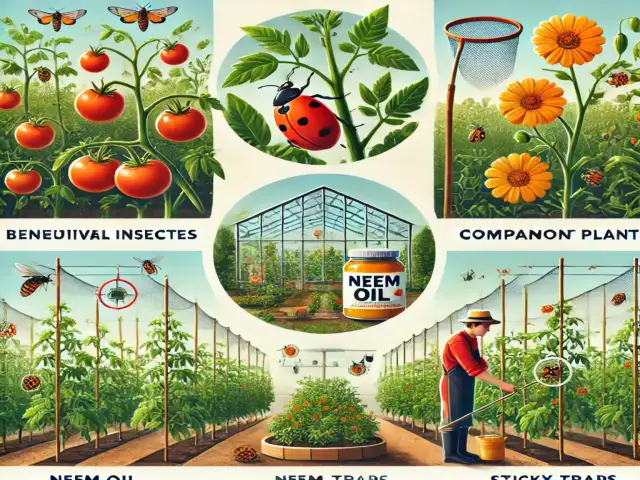
Keeping pests away from plants is important. In an organic greenhouse, this must be done without chemicals. Let’s look at some ways to control pests naturally.
Natural Pest Control Methods
- Beneficial Insects: Some insects are good for your plants. Ladybugs and lacewings eat harmful pests.
- Companion Planting: Planting certain plants together can keep pests away. For example, marigolds can protect tomatoes from pests. This method is called companion planting.
- Neem Oil: Neem oil is a natural pesticide made from the neem tree.
- Sticky Traps: Sticky traps can catch flying pests. These traps surround the greenhouse to catch insects like flies and aphids.
- Handpicking: Sometimes, the best way to get rid of pests is by hand. Checking plants regularly and removing pests by hand can be very effective.
Benefits of Natural Pest Control
- Safe for Plants and People: Natural pest control methods are safe for both plants and people. They do not leave harmful residues on your crops.
- Environmentally Friendly: These methods do not harm the environment. They keep the greenhouse ecosystem balanced and healthy.
Pest control in an organic greenhouse can be done without chemicals.
Cost Implications of Organic Greenhouse Farming
Starting and running an organic greenhouse can be costly. Understanding these costs is important for planning your budget properly. Let’s explore the different expenses involved.
Initial Costs
- Greenhouse Construction: Building a greenhouse can be expensive. Materials like glass, plastic, and metal are needed, and the size and type of greenhouse affect the cost.
- Organic Supplies: You will need organic seeds, soil, and fertilisers, which are often more expensive than non-organic ones.
- Irrigation System: Setting up a good irrigation system is crucial. It helps water the plants properly. This system can be costly to install.
Ongoing Costs
- Labor Costs: Organic farming requires more manual work. This increases labour costs.
- Energy Costs: Running a greenhouse uses energy for heating, cooling, and lighting.
- Maintenance Costs: Regular maintenance of the greenhouse is necessary. This includes repairing structures and replacing equipment. Maintenance costs keep your greenhouse in good condition.
Economic Benefits
- Higher Selling Prices: Organic produce often sells for higher prices. This can offset some of the higher costs involved in organic farming.
- Market Demand: There is a growing demand for organic products. Many people are willing to pay more for food grown without chemicals.
Maintaining Soil Fertility in an Organic Greenhouse
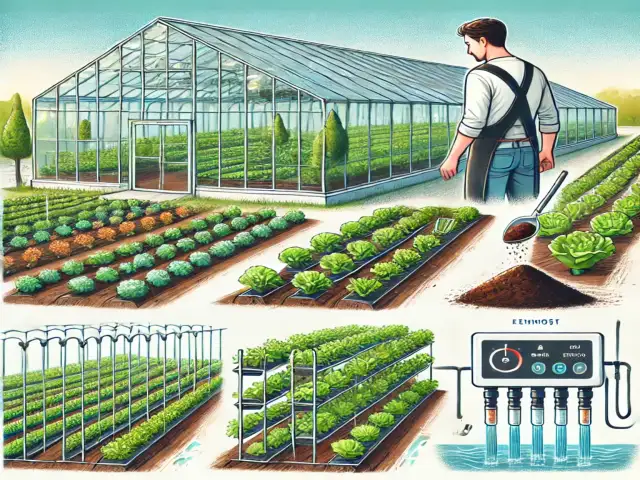
In an organic greenhouse, keeping the soil healthy is very important. Let’s see how to do this.
How to Keep Soil Fertile
- Compost: Compost is made from old plants and food scraps. It is full of nutrients that plants need. Adding compost to the soil helps keep it fertile.
- Cover Crops: Cover crops like clover or rye are grown to protect and enrich the soil. They add nutrients and help prevent soil erosion.
- Crop Rotation: Crop rotation means changing the type of plants grown in the same soil each season. This helps prevent the soil from losing important nutrients.
- Organic Fertilizers: Organic fertilisers, such as manure and bone meal, provide nutrients to the soil. These natural fertilisers are safe and effective.
- Mulching: Mulching means covering the soil with materials like straw or leaves. This helps keep moisture in the soil and adds nutrients as it breaks down.
Benefits of Healthy Soil
Strong Plants: Healthy soil helps plants grow strong and resist pests and diseases.
Better Yield: Fertile soil leads to better crop yields, meaning more fruits and vegetables.
Maintaining soil fertility in an organic greenhouse is essential. Healthy soil means strong plants and better yields.
Profitability of Organic Greenhouse Farming
Organic greenhouse farming can be a profitable way to earn money. Although it costs more to start and run, the rewards can be worth it. Let’s explore how organic greenhouse farming can be profitable.
Ways to Make Organic Greenhouse Farming Profitable
High Selling Prices
Organic produce often sells for higher prices than non-organic produce. People are willing to pay more for food that is grown without chemicals.
Market Demand
There is a growing demand for organic products. More people are looking for healthy, chemical-free food, which means more customers for your produce.
Cost Savings on Chemicals
Organic farming does not use chemical fertilisers and pesticides. This can save money in the long run.
Government Incentives
Some governments offer financial support for organic farming. These incentives can help reduce costs.
Direct Selling
Selling directly to consumers, such as at farmers’ markets, can increase profits. It cuts out the middleman and allows farmers to keep more money.
Challenges to Profitability
- High Initial Costs: Starting an organic greenhouse can be expensive. Costs include building the greenhouse and buying organic supplies.
- Labor Costs: Organic farming often requires more manual labour, which can be costly.
Best Practices for Organic Greenhouse Farming
Let’s look at some of these best practices.
Effective Farming Techniques
Proper Ventilation
Good airflow is essential in a greenhouse. Proper ventilation helps control temperature and humidity, keeping plants healthy.
Regular Monitoring
Check plants regularly for pests, diseases, and nutrient levels. Early detection helps manage problems before they become big issues.
Using Organic Seeds
Use certified organic seeds. These seeds are not treated with chemicals and are better suited for organic farming.
Water Management
Water plants properly to avoid over-watering or under-watering. Drip irrigation systems are effective and save water.
Natural Pest Control
Use natural methods to control pests, such as introducing beneficial insects and using neem oil.
Soil Health Maintenance
Regularly add compost and organic fertilisers to keep the soil fertile, rotate crops, and use cover crops.
Benefits of Best Practices
- Healthier Plants: Following best practices leads to healthier plants that produce more fruits and vegetables.
- Sustainable Farming: Best practices help ensure that farming methods are sustainable and do not harm the environment.
Starting an Organic Greenhouse Farm
Let’s learn the steps to start a successful organic greenhouse farm.
Step 1: Choose a Good Location
- Find a Sunny Spot: Your greenhouse needs plenty of sunlight. Choose a location that gets lots of natural light.
- Check the Soil: Make sure the soil is good for growing plants. It should be rich and well-drained.
Step 2: Design Your Greenhouse
- Decide on the Size: Think about how big you want your greenhouse to be. A bigger greenhouse means more plants but also more work.
- Choose the Materials: Greenhouses can be made from glass, plastic, or metal. Choose materials that are strong and last long.
Step 3: Gather Organic Supplies
- Get Organic Seeds: Buy seeds that are certified organic. These seeds are not treated with chemicals.
- Prepare the Soil: Use organic soil and compost. These will provide the nutrients your plants need.
- Set Up Watering Systems: Install a good irrigation system. Drip irrigation works well and saves water.
Step 4: Plant Your Crops
- Start with Easy Crops: Begin with plants that are easy to grow, like tomatoes, lettuce, and herbs.
- Plant in Rows or Beds: Arrange your plants in rows or beds for easy access and care.
Step 5: Maintain Your Greenhouse
- Monitor Temperature and Humidity: Keep an eye on the temperature and humidity levels. Use fans and vents to control the climate.
- Control Pests Naturally: Use natural pest control methods like beneficial insects and neem oil.
- Regularly Add Nutrients: Keep the soil healthy by regularly adding compost and organic fertilisers.
Costs and Planning
- Initial Costs: Building a greenhouse and buying supplies can be expensive. Plan your budget carefully.
- Ongoing Costs: You will need to pay for water, electricity, and labour. Track these expenses to manage your budget.
Benefits of Organic Greenhouse Farming
- Healthy Plants: Growing plants organically means they are free from harmful chemicals.
- High Demand: People love organic produce. You can sell your crops for higher prices.
- Environmentally Friendly: Organic farming is good for the environment. It helps keep the soil, water, and air clean.
Starting an organic greenhouse farm takes planning and hard work. Choose a good location, design your greenhouse, gather organic supplies, and start planting. By maintaining your greenhouse carefully, you can grow healthy, organic plants. This rewarding process provides healthy food for people and helps protect the environment.
Organic greenhouse farming is a sustainable and environmentally friendly way to grow plants. By using natural farming techniques and avoiding chemicals, farmers can produce healthy crops. This method benefits the environment and can be profitable. Anyone can start and maintain an organic greenhouse farm by following best practices and carefully managing costs. Organic greenhouse farming is a great way to contribute to a healthier planet and enjoy fresh, organic produce.





